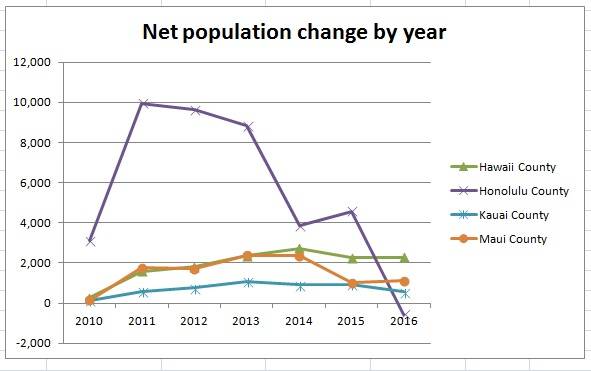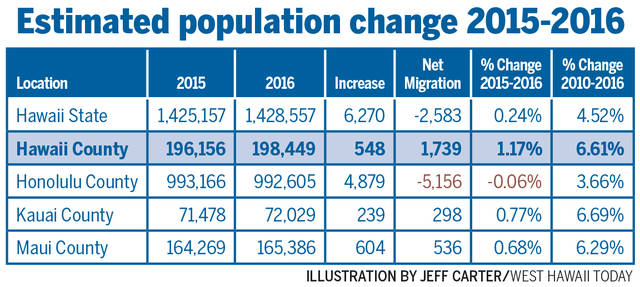HILO — More people flew here than grew here last year, as Hawaii Island led the state in several measures of population increases, according to estimates released late Wednesday by the U.S. Census Bureau. ADVERTISING HILO — More people flew
HILO — More people flew here than grew here last year, as Hawaii Island led the state in several measures of population increases, according to estimates released late Wednesday by the U.S. Census Bureau.
With Oahu losing population between 2015 and 2016, Hawaii County led the state in overall percentage increase in residents, while also leading in the number of people moving here, according to the Census Bureau estimates.
In fact, Hawaii Island had the third-largest population increase in raw numbers of the 551 micropolitan statistical areas in the nation, behind Bozeman, Montana, and Dunn, North Carolina. A micropolitan statistical area, like the larger metropolitan statistical area, is a labor market area centered on an urban cluster, in this case, Hilo.
Hawaii County gained 2,287 people — averaging more than six new people a day — between June 30, 2015, and July 1, 2016. Of those, 1,739 moved here, while 548 were the increase of births over deaths.
“I was just telling someone the other day, ‘Boy, there’s a lot of new people here,’” said Mayor Harry Kim when told about the data.
Of the 1,739 people estimated to have immigrated to Hawaii County last year, 679 arrived from international origins, with the rest coming from within the state or from the mainland.
“I think it’s a very positive thing that people love the lifestyle here,” said Kim. “We need to protect these things that make Hawaii Island special. The world is going to discover our island more and more.”
In a six-year comparison between 2010 and 2016, Hawaii County’s growth rate of 6.61 percent was edged out by Kauai, whose 6.69 percent increase was the highest in the state. Percentage increases can be misleading when they’re derived from a lower base, however.
A net exodus of 5,156 people from Oahu last year brought its population down by 0.06 percent and dragged the state down to a scant 0.24 percent growth rate for the year. It’s the first year since 2007 that Oahu lost more people than it gained.
Yang-Seon Kim, research and statistics officer in the state Department of Business, Economic Development and Tourism’s Research and Economic Analysis Division, cautioned that the latest census figures are only estimates derived from births and death data, tax returns and other vital records. The population is counted only every 10 years, and the intervening years are estimated, she said.
The Census Bureau adjusts each year’s estimates as new information comes in. Immigration data, which had the largest impact on the newest estimate, are particularly difficult to estimate, she said.
“I don’t want to think so, but it’s possible. We can’t say it’s not actual,” the analyst said about Oahu’s population loss. “This is only an estimate. … At this point in time, nobody can tell what’s actually happened.”
The state population in 2016 was estimated at 1.428 million, with Oahu’s at 992,605, Hawaii County’s at 198,449, Maui County’s at 165,386 and Kauai County’s at 72,029.
One segment of Hawaii Island’s population increase is of special concern to Kim. He said homeless individuals in the annual point in time count increased from 557 in 2013 to 1,394 in December. Of those, 17 percent had lived in Hawaii less than a year, and 51 percent were homeless for the first time, he said.
He said he can understand people moving from Oahu to the neighbor islands. With median home values there at $740,000, it can be hard to make ends meet, he said.
“If you have a dream of owning your own home,” he said, “you’re not going to look at Oahu very long.”




